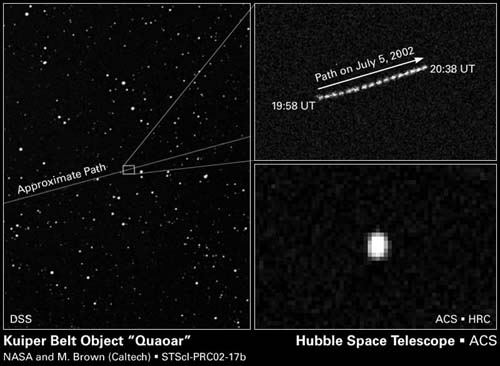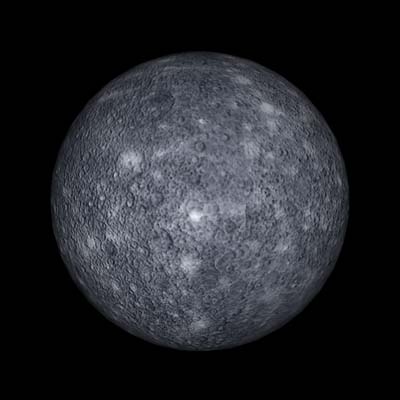50000 Quaoar
One of the largest known Kuiper Belt objects. Quaor (KWAH-o-ar) was discovered in June 2002 by Chad Trujillo and Mike Brown at the California Institute of Technology. It was provisionally named 2002 LM60 before being permanently named Quaor after the creation force of the Tongva tribe who were the original inhabitants of the Los Angeles basin, where the Caltech campus is located.
Quaoar lies about 42 AU (6.5 billion km) away from us, more distant than either Pluto or Neptune, and moves in a nearly circular orbit with an eccentricity of less than 0.04, meaning that its distance from the Sun changes by only about 8% over the course of a Quaoar year (equal to 285 Earth years). This is very different from Pluto, which has an eccentricity about 6 times larger.
The diameter of Quaor is estimated to be 1,300 km (800 miles), about the size of Pluto's moon Charon. This gives Quaoar a volume about the same as that of all the asteroids put together.
Quaoar received the minor planet number 50,000, which was not by coincidence but to commemorate its large size, as it was found while searching for a Pluto-sized object in the Kuiper belt.
Quaoar has a known moon, Weywot, discovered in 2006. It is believed to have a diameter of around 170 km.

Quaoar as seen by Hubble Space Telescope.
| Quaoar Facts* | |
| Discoverer | Chad Trujillo, Michael E. Brown |
| Discovery date | june 4, 2002 |
| Diameter | 1,121 km |
| Mass | 1.4 x 1021 kg |
| Density | 1.99 g/cm3 |
| Eccentricity | 0.039 |
| Inclination | 7.98° |
| Semi-major axis | 43.692 AU |
| Perihelion | 41.964 AU |
| Aphelion | 45.418 AU |
| Orbital period | 288.78 years |
| Albedo | 0.109 |
| Surface temp. | ⁓ 44 K |
| Absolute magnitude | 2.7 |
* Data from Wikipedia 2020

